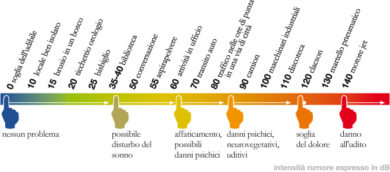Noise and noise pollution
Sound is part of our daily life. However, if a small amount of noise is acceptable, excessive or long exposure into noisy environment, up to noise pollution, can have negative consequences for health.
In France, since 1963, noise has been considered a professional disease and some research estimated that over 3 million people are exposed to this risk in their workplace.
What is noise?
In acoustics, noise is given by the sum of the many sounds that we perceive simultaneously.
This phenomenon, like sounds in general, consists of sound pressure waves.
Human perception of sound varies depending on the noise level and frequency.
The noise level, which determines if a sound is strong or weak, is expressed in decibels (dB), the measures of sound pressure level.
The frequency refers to how often the particles of the medium vibrate when a wave passes through the medium and it is expressed in hertz (Hz): much higher is the frequency, more the sound is acute.
The different levels of noise
Level 0 dB is the threshold of human hearing. Each time the sound level increases by 3 dB, the amount of perceived noise doubles because the sound level follows a logarithmic scale.
For example, the sum of two sound sources of 80 dB each produces an overall level of 83 dB.
Noise level
Noise intensity is measured in a scale that goes from 10 to 130 dB:
- from 10 to 40 dB: slight noise (rustle of wind between the leaves, desert);
- from 40 to 60 dB: bearable noise (quiet office, normal conversation);
- from 60 to 80 dB: annoying sounds (busy street, television, canteen);
- from 80 to 100 dB: dangerous noise (a train, high music);
- from 100 to 130 dB: dangerous to painful sounds (steel mill, pneumatic hammer, aircraft reaction motors).

Noise in working spaces
A wrong attention to the acoustic aspects of a workspace can produce negative effects to health of people that work in these environments. In this sense, legislation is constantly evolving.
The office space organization is one of the essential components for life quality in the workplace and deserves to be considered as an important lever for professional well-being.
Some companies consider the layout of work areas as a management tool in its entirety. It is therefore necessary to take into account the acoustic problems by implementing solutions in order to minimize the discomfort and stress generated by excessively noisy environments.
Noise in the offices results from the overlapping of the sounds produced by the people and the equipment used (computers, copiers, keyboard noise, discussions, etc.)
Noises cause obstacles for understanding in verbal exchanges, decreases performance, disturbs concentration and increases tiredness. We recall that the optimum sound level of an office is between 30 and 45 dB, a noise level that can be found between a quiet garden and a quiet restaurant room.
With the multiplication of shared workspaces, reducing noise in open spaces as well as in coworking rooms has become an essential condition for well-being in order to guarantee an effective level of concentration, as well as an element to be taken into consideration by employees and personnel that reflects the level of services offered by companies and the working environment.
